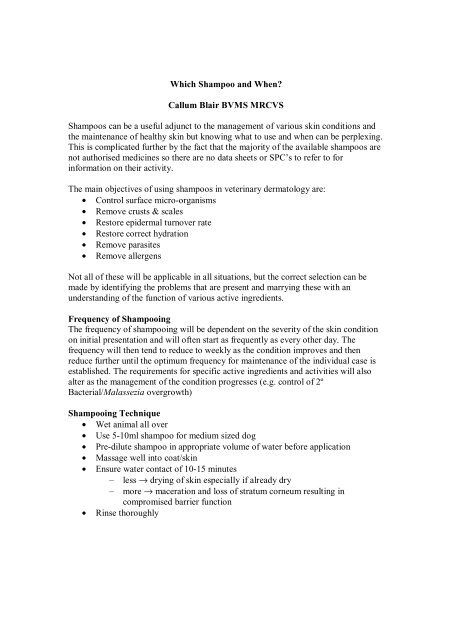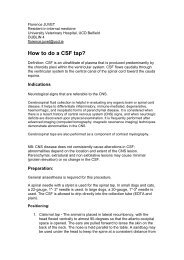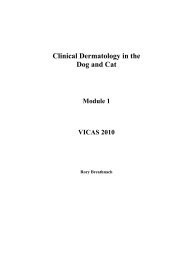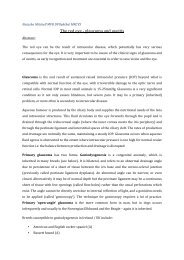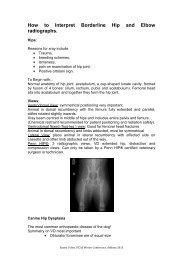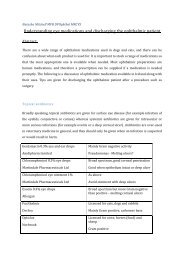CB_VICAS Which Shampoo and When - Love My Pet
CB_VICAS Which Shampoo and When - Love My Pet
CB_VICAS Which Shampoo and When - Love My Pet
Create successful ePaper yourself
Turn your PDF publications into a flip-book with our unique Google optimized e-Paper software.
<strong>Which</strong> <strong>Shampoo</strong> <strong>and</strong> <strong>When</strong><br />
Callum Blair BVMS MRCVS<br />
<strong>Shampoo</strong>s can be a useful adjunct to the management of various skin conditions <strong>and</strong><br />
the maintenance of healthy skin but knowing what to use <strong>and</strong> when can be perplexing.<br />
This is complicated further by the fact that the majority of the available shampoos are<br />
not authorised medicines so there are no data sheets or SPC’s to refer to for<br />
information on their activity.<br />
The main objectives of using shampoos in veterinary dermatology are:<br />
• Control surface micro-organisms<br />
• Remove crusts & scales<br />
• Restore epidermal turnover rate<br />
• Restore correct hydration<br />
• Remove parasites<br />
• Remove allergens<br />
Not all of these will be applicable in all situations, but the correct selection can be<br />
made by identifying the problems that are present <strong>and</strong> marrying these with an<br />
underst<strong>and</strong>ing of the function of various active ingredients.<br />
Frequency of <strong>Shampoo</strong>ing<br />
The frequency of shampooing will be dependent on the severity of the skin condition<br />
on initial presentation <strong>and</strong> will often start as frequently as every other day. The<br />
frequency will then tend to reduce to weekly as the condition improves <strong>and</strong> then<br />
reduce further until the optimum frequency for maintenance of the individual case is<br />
established. The requirements for specific active ingredients <strong>and</strong> activities will also<br />
alter as the management of the condition progresses (e.g. control of 2º<br />
Bacterial/Malassezia overgrowth)<br />
<strong>Shampoo</strong>ing Technique<br />
• Wet animal all over<br />
• Use 5-10ml shampoo for medium sized dog<br />
• Pre-dilute shampoo in appropriate volume of water before application<br />
• Massage well into coat/skin<br />
• Ensure water contact of 10-15 minutes<br />
– less → drying of skin especially if already dry<br />
– more → maceration <strong>and</strong> loss of stratum corneum resulting in<br />
compromised barrier function<br />
• Rinse thoroughly
The main conditions where shampoos may be of interest are:<br />
• Routine Skin Care<br />
• Pyoderma<br />
• Excessive scale – Greasy or Dry<br />
• Atopy<br />
Routine Skin Care<br />
There are a number of myths surrounding the routine shampooing of cats <strong>and</strong> dogs.<br />
<strong>My</strong>th<br />
Dog’s skin is the same as<br />
human skin<br />
Regular shampooing dries<br />
the skin<br />
It is normal for dog’s skin<br />
to smell<br />
Reality<br />
The pH of dog skin is ~7.5<br />
<strong>and</strong> human skin is ~5.5<br />
Only if inappropriate<br />
shampoos are used<br />
So-called ‘doggy smell’ is<br />
the fatty acids in superficial<br />
skin gone rancid<br />
The important issue is that the shampoo should be formulated for use in dogs <strong>and</strong>/or<br />
cats. <strong>When</strong> considering the need for routine shampooing the effect of the unnatural<br />
environment that we keep dogs in should be taken into account. Factors such as the<br />
dehydrating effect of central heating, the effect of man-made fibres on the build up of<br />
static charge on the coat <strong>and</strong> the ubiquitous nature of house dust mites in modern<br />
households all conspire to undermine the health of the skin of even a normal dog.<br />
<strong>Shampoo</strong>s for routine use should provide three main properties: emollient<br />
(moisturiser), conditioner <strong>and</strong> cleansing agents. This will help to counteract the<br />
environmental assault on the skin as well as removal of general dust, dirt <strong>and</strong> debris.<br />
The Benefits of Using Properly Formulated <strong>Shampoo</strong>s<br />
CLEANSING<br />
Removes old skin cells, dirt<br />
<strong>and</strong> rancid fat. Cleans pores<br />
to allow correct flow of oils.<br />
CONDITIONING<br />
Closes up scales on hairs so<br />
imparts shine <strong>and</strong> lessens<br />
opportunity for dirt etc to<br />
collect on coat. Anti-static.<br />
ALLERGEN REDUCTION<br />
Reduces risk of some skin<br />
conditions in predilection breeds<br />
such as Westies by physical<br />
allergen removal<br />
RE-HYDRATION<br />
Puts moisture back into the<br />
skin which is often lost due<br />
to environmental pressure.
Examples of ingredients included to provide these properties are:<br />
• Urea/Lactic acid – Hygroscopic (attract water to skin), emollient &<br />
humectant<br />
• Glycerine/propylene glycol – Cosmetic (applies shine), conditioning <strong>and</strong><br />
prevents water loss through skin (humectant)<br />
• Non-soap cleansing compounds (e.g. olefin sulphonate)<br />
An example of a routine shampoo is Sebocalm (Urea + Glycerine + olefin<br />
sulphonate), Virbac.<br />
Some plant extracts such as oatmeal <strong>and</strong> aloe vera are reported to have soothing as<br />
well as emollient properties. <strong>Shampoo</strong>s based on these ingredients can be used for<br />
routine shampooing as well as soothing itchy skin or in dogs prone to itchy skin.<br />
Examples of these shampoos are Coatex Aloe <strong>and</strong> Oatmeal (Aloe Vera + Oatmeal),<br />
VetPlus <strong>and</strong> Episoothe (colloidal oatmeal), Virbac.<br />
Pyoderma<br />
It should be determined whether either deep or superficial pyoderma is present <strong>and</strong> the<br />
coexistence of other problems such as folliculitis, damaged skin <strong>and</strong> possible<br />
associated greasiness identified. Pyoderma may also be a secondary or complicating<br />
factor in a variety of other primary conditions such as those listed below.<br />
Chlorhexidine (e.g. Malaseb, VetXX in conjunction with Miconazole)<br />
• Antibacterial - residual effect (binds to keratin)<br />
• Antifungal<br />
• Drying<br />
2.5% Benzoyl Peroxide (e.g. Paxcutol, Virbac)<br />
• Keratolytic<br />
• Follicular flusher (i.e. really deep cleanser)<br />
• Potent antimicrobial - bacteria/fungi/yeasts<br />
• Potent degreaser<br />
• Good idea to use with humectant<br />
• Useful adjunct to Demodex Therapy<br />
In animals susceptible to pyoderma it is worth considering routine shampooing to<br />
maintain skin health.<br />
10 % Ethyl Lactate (1,2) (e.g. Etiderm, Virbac; Lactaderm, Vetoquinol)<br />
• Releases ethanol <strong>and</strong> lactic acid following contact with the skin<br />
• Lactic acid:<br />
o keratoplastic properties<br />
o anti-bacterial by lowering skin pH<br />
• Ethanol<br />
o Antibacterial <strong>and</strong> antifungal properties<br />
o degreasing agent
Excessive Scale – Dry or Greasy<br />
These cases will often present with bacterial (commonly Staph. intermedius) <strong>and</strong>/or<br />
Malassezia pachydermatis overgrowth. A combination of Chlorhexidine <strong>and</strong><br />
Miconazole (Malaseb, VetXX) authorised in the UK is specifically formulated for this<br />
purpose <strong>and</strong> has a proven track record in the treatment of this problem. <strong>When</strong><br />
overgrowth has been brought under control these cases will often show a significant<br />
clinical improvement. Once this is achieved, targeted use of keratoplastic <strong>and</strong><br />
keratolytic agents will help maintain this improvement, these are summarised in the<br />
table below (1) :<br />
Agent Keratolytic Keratoplastic Degreasing Other<br />
Ammonium Lactate<br />
Benzoyl Peroxide<br />
Antimicrobial<br />
Coal/Pine Tar<br />
anti-pruritic<br />
Salicylic acid<br />
Bacteriostatic, mildly<br />
soothing<br />
Selenium sulphide Antifungal at 2.5%<br />
Sulphur (mild) Antibacterial,<br />
antifungal<br />
In addition to these primarily keratolytic/keratoplastic agents, shampoos for dogs<br />
prone to excessive scurf may include a specific anti-bacterial <strong>and</strong>/or anti-fungal agent<br />
to maintain the microbial health of the skin:<br />
• Chloroxylenol – Antibacterial agent (found in Dettol)<br />
• Piroctone Olamine – broad spectrum antibacterial <strong>and</strong> antifungal<br />
Formulations of shampoos used in the management of dogs suffering from excessive<br />
scale including miscellaneous ingredients:<br />
<strong>Shampoo</strong> Company Ingredients Dry/Greasy<br />
Coatex Medicated VetPlus Chloroxylenol<br />
Salicylic acid<br />
Mildly Dry –<br />
Greasy<br />
Sodium thiosulphate (sulphur)<br />
Sebolytic Virbac Salicylic acid (2%)<br />
Greasy<br />
Linoleic acid & γ-Linolenic acid<br />
• Maintain barrier function <strong>and</strong><br />
health of keratinocytes<br />
Zinc gluconate & Vitamin B6<br />
• Inhibit sebum secretion<br />
Piroctone Olamine<br />
Sebomild P Virbac Ammonium Lactate<br />
Piroctone Olamine<br />
Dry – Mildly<br />
Greasy<br />
Seleen CEVA Selenium Sulphide Greasy
Atopy<br />
It has now been established that percutaneous penetration of allergens present on the<br />
skin surface plays an important role in the development of atopic dermatitis (3,4) .<br />
Two factors increase the significance of this in the domestic environment. Firstly<br />
positively charged House Dust Mites are attracted to the negative charge on dogs’<br />
coats <strong>and</strong> secondly it has been identified that affected dogs suffer from epidermal<br />
structural modifications (5,6) which compromise lipid (mainly linoleic acid) barrier<br />
function (7) . The net effect is to both increase the level of topical antigenic challenge<br />
<strong>and</strong> the potential for absorption of these antigens. Dogs suffering from atopy also<br />
frequently suffer from bacterial/malassezia overgrowth so initially<br />
Chlorhexidine/Miconazole may be indicated. As in dogs with excessive scale once<br />
overgrowth is brought under control the need for shampoo ingredients will change.<br />
The shampoos based on plant extracts oatmeal <strong>and</strong> aloe vera, mentioned previously,<br />
can also be used for soothing itchy skin <strong>and</strong> have conditioning <strong>and</strong> emollient<br />
properties. A variety of other ingredients have been formulated into a foaming microemulsion<br />
(Allermyl, Virbac) specifically to maintain the health of skin in dogs<br />
susceptible to atopy:<br />
• Linoleic acid – help to replace lost superficial lipids <strong>and</strong> address the<br />
compromised barrier function<br />
• Conditioner – neutralise the negative charge on coat <strong>and</strong> reduce attraction to<br />
HDM<br />
• Vitamin E – Anti-oxidant <strong>and</strong> soothing<br />
• Glycotechnology (e.g Monosaccharides fucose + rhamnose) new concept in<br />
dermatology have soothing properties <strong>and</strong> disrupt formation of bacterial<br />
colonies (8)<br />
• Piroctone olamine – Antibacterial/Antifungal Agent<br />
REFERENCES<br />
1. Curtis, C., (1998) Use <strong>and</strong> abuse of topical dermatological therapy in dogs <strong>and</strong><br />
cats Part 1. <strong>Shampoo</strong> therapy. In Practice 20: 244 – 251.<br />
2. de Jaham, C., (2003). Effects of an ethyl lactate shampoo in conjunction with a<br />
systemic antibiotic in the treatment of canine superficial bacterial pyoderma in<br />
an open-label, nonplacebo-controlled study. Vet Therapeutics 4(1):94-100<br />
3. White S.D. & Bourdeau P., (1995). – Canine atopy: an update of new data. Le<br />
Point Vétérinaire, 27 (169), 11-21.<br />
4. Halliwell R.E.W. (2000). Atopic dermatitis: clinical signs <strong>and</strong> diagnosis -<br />
Proceeding of the 4th World Congress of Veterinary Dermatology, San<br />
Francisco, California, USA.
5. Scott D.W., Miller W.H. & Griffin C.E., (1995). Immunologic Skin Diseases -<br />
In Muller & Kirk’s Small Animal Dermatology, 1995, 5th ed., 502.<br />
6. Koch H.J., (2000). Atopic dermatitis: treatments old <strong>and</strong> new - Proceeding of<br />
the 4th World Congress of Veterinary Dermatology, San Francisco, California,<br />
USA.<br />
7. Kwochka K.W., (1993). The Structure <strong>and</strong> Function of Epidermal Lipids -<br />
Veterinary Dermatology, 4(4), 151-9.<br />
8. Lloyd, D.H., Viac, J., Werling, D., Rème, C.A., Gatto, H., (2007). Role of<br />
sugars in surface microbe–host interactions <strong>and</strong> immune reaction modulation.<br />
Vet Dermatology 18(4):197-204.


